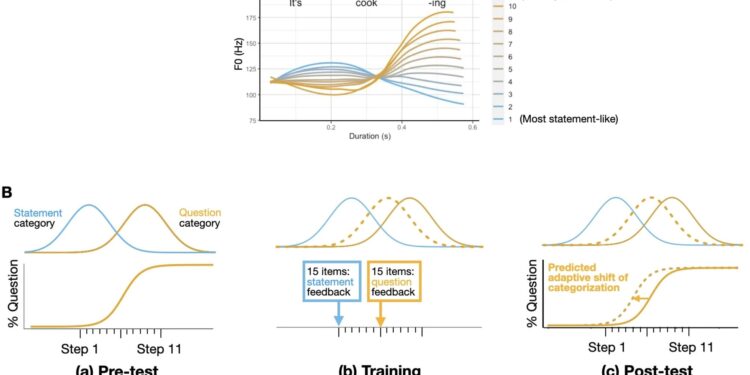Stimuli and course of the adaptation task. Credit: Scientific reports (2024). DOI: 10.1038/s41598-024-66569-x
A new study finds that difficulties adapting to changes in speech patterns may affect how autistic teens understand tone and meaning.
Verbal communication is not just about the words we use, but also how we say them. For example, the phrase “I can’t believe it” can convey surprise if spoken with a rising intonation or sarcasm if spoken with a flat tone. Emphasizing different words or changing the pace of speech can significantly change the message being conveyed.
Researchers have long known that interpreting these language variations can cause problems for people with autism, but they don’t know exactly why.
According to a new study from the University of Rochester, this could be because their brains have difficulty processing and adapting to changes in speech patterns. In a paper published in Scientific reportsResearchers including Chigusa Kurumada, associate professor in the Department of Brain and Cognitive Sciences, and Loisa Bennetto, associate professor in the Departments of Psychology, Brain and Cognitive Sciences, and Neuroscience, highlight a complex intersection between sensory processing and cognitive interpretation, offering new insights into the diverse ways people experience and interpret communication.
Understanding speech prosody
The researchers studied adolescents ages 12 to 17, with and without autism, and how each group understood speech prosody. Prosody refers to the use of changes in pitch, rhythm, volume, and timing to express meaning and emotion. Distinguishing a question from a statement (is it raining? or “it’s raining”) or expressing excitement, sadness, or sarcasm are all examples of prosody.
Adolescence is a particularly interesting time from a speech science perspective, Kurumada says, because “it’s a time when children’s social networks expand dramatically, as do their linguistic experiences, as their brains develop to pay more attention to unfamiliar voices.”
For people with autism, this stage of development often presents challenges, particularly in understanding the subtleties of speech prosody. Researchers have traditionally attributed speech prosody problems to either reduced sensitivity to subtle sound variations or difficulties interpreting social cues that convey the thoughts and emotions of others.
Kurumada, Bennetto and their team tested more than 150 participants and found that autism was linked to perceptual inflexibility, or a reduced ability to adapt to the constant changes and variations in human speech.
“Our paper is one of the first to show that perceptual inflexibility affects linguistic communication,” Kurumada says.
Next Steps in Exploring Perceptual Inflexibility
In everyday conversation, people exhibit great diversity in the way they use prosody to convey a message. To grasp each speaker’s intention, listeners must constantly adjust their perception to account for these individual variations in vocal style.
As Kurumada, Bennetto and their team discovered, challenges with speech prosody have to do with how the brain processes and interprets auditory information and how flexible we are in adapting our understanding of different prosodies.
The research provides a new explanation for why oral communication is more difficult in autistic adolescents than in non-autistic adolescents, particularly at a stage of development when social interactions become considerably more diverse and require the flexibility to manage them.
Bennetto says future research will explore how this adaptability develops from childhood to adolescence, in both autistic and non-autistic children.
Bennetto explains: “Reduced perceptual and linguistic flexibility may be a cause of social communication difficulties in autism, or a consequence of limited or different social experiences in childhood. It is essential to understand how neurocognitive diversity can shape children’s linguistic development.”
More information:
Chigusa Kurumada et al, Perception and adaptation of receptive prosody in autistic adolescents, Scientific reports (2024). DOI: 10.1038/s41598-024-66569-x
Provided by the University of Rochester
Quote: Why Autistic Teens Struggle with Nonverbal Cues (2024, September 16) retrieved September 16, 2024 from
This document is subject to copyright. Apart from any fair dealing for the purpose of private study or research, no part may be reproduced without written permission. The content is provided for informational purposes only.



